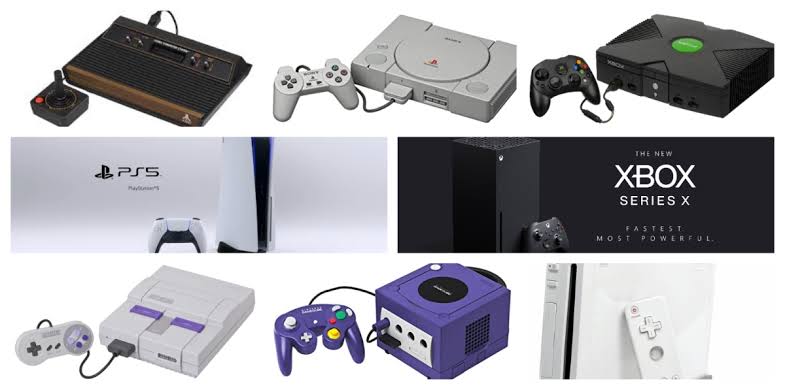See how gaming consoles transformed over the years
The evolution of gaming consoles is fascinating journey that spans several decades. It is marked by technological advancements. Changing consumer preferences also influence it. From rudimentary systems of 1970s to sophisticated. Multi-functional devices we have now gaming consoles have transformed significantly. This article explores milestones in history of gaming consoles. It highlights key developments that shaped gaming industry.
The Early Days: First Generation Consoles
The journey of gaming consoles began in early 1970s with first generation of systems. Magnavox Odyssey released in 1972, is widely regarded as first commercial home video game console. It was simple device that connected to television. It used cartridges to play various games. Graphics were basic. Consisting of simple lines and dots. The gameplay was straightforward
Around the same time Atari released Pong. A home version of its popular arcade game. Pong was major hit. Played crucial role in popularizing video games. These early consoles laid foundation for gaming industry. Introducing concept of home entertainment through video games.
The Rise of Cartridge-Based Systems: Second Generation
The second generation of consoles, emerging in late 1970s and early 1980s saw introduction of more advanced systems with interchangeable cartridges. This innovation allowed players to purchase. And play multiple games on single console. The Atari 2600, released in 1977 was pioneer in this era. It featured improved graphics and sound. A wide range of games. Making it immensely popular
Other notable consoles from this generation include the Intellivision by Mattel and the ColecoVision by Coleco. These systems offered better graphics and more complex gameplay, setting the stage for the future of gaming consoles.
The Video Game Crash and the Rise of Nintendo: Third Generation
The early 1980s witnessed a significant setback in the gaming industry, known as the video game crash of 1983. The market was flooded with low-quality games and poorly designed consoles, leading to a loss of consumer confidence and a sharp decline in sales.
However, the industry was revitalized by the entry of Nintendo with its Nintendo Entertainment System (NES) in 1985. The NES brought a new level of quality and innovation, featuring iconic games like Super Mario Bros., The Legend of Zelda, and Metroid. The console's success was bolstered by Nintendo's strict quality control measures and its innovative marketing strategies.
Nintendo's impact on the gaming industry was profound, ushering in a new era of video games and setting high standards for future consoles.
The Battle of the Giants: Fourth Generation
The fourth generation, also known as the 16-bit era, saw intense competition between major players like Nintendo and Sega. Nintendo's Super Nintendo Entertainment System (SNES) and Sega's Genesis (Mega Drive in some regions) were the dominant consoles of this era.
The SNES and Genesis featured significant improvements in graphics, sound, and gameplay complexity. Iconic games like Sonic the Hedgehog, Street Fighter II, and Super Mario World became cultural phenomena. This period also saw the rise of role-playing games (RPGs) and more intricate storytelling in video games.
The Advent of 3D Graphics: Fifth Generation
The fifth generation of consoles, emerging in the mid-1990s, marked a major leap forward with the introduction of 3D graphics. Sony entered the market with its PlayStation in 1994, revolutionizing the industry with its CD-based games and powerful hardware. The PlayStation's success was driven by iconic titles such as Final Fantasy VII, Metal Gear Solid, and Resident Evil.
Nintendo continued its legacy with the Nintendo 64, which also featured 3D graphics and introduced the world to beloved games like Super Mario 64 and The Legend of Zelda: Ocarina of Time. These consoles redefined gaming experiences, offering more immersive worlds and complex gameplay mechanics.
The Era of Online Gaming: Sixth Generation
The sixth generation, starting in the early 2000s, saw the rise of online gaming and more advanced hardware. Sony's PlayStation 2, released in 2000, became the best-selling console of all time, thanks to its extensive game library and backward compatibility with PlayStation games.
Microsoft entered the console market with the Xbox in 2001, introducing online gaming through Xbox Live. This service allowed players to compete and cooperate over the internet, transforming the social aspect of gaming.
Nintendo's GameCube also made its mark during this period, offering innovative games and unique controller designs. The focus on online capabilities and enhanced graphics set the stage for the modern era of gaming.
The High-Definition Revolution: Seventh Generation
The seventh generation, beginning in the mid-2000s, brought high-definition (HD) graphics and more powerful processing capabilities. Sony's PlayStation 3 and Microsoft's Xbox 360 were at the forefront of this era, offering advanced graphics, online services, and multimedia capabilities.
Nintendo took a different approach with the Wii, focusing on motion-controlled gaming and appealing to a broader audience, including families and casual gamers. The Wii's innovative control scheme and popular games like Wii Sports and Mario Kart Wii made it a massive success.
The Current Landscape: Eighth and Ninth Generations
The eighth generation, starting around 2013, introduced even more powerful consoles with enhanced graphics, virtual reality (VR) capabilities, and expanded online services. Sony's PlayStation 4 and Microsoft's Xbox One continued to push the boundaries of gaming technology, while Nintendo's Wii U and later the Nintendo Switch offered unique gaming experiences with their hybrid designs.
As we move into the ninth generation, the PlayStation 5 and Xbox Series X/S have taken center stage, offering unprecedented processing power, ray tracing graphics, and faster load times. These consoles are designed to provide seamless and immersive gaming experiences, with a strong focus on online services, streaming, and backward compatibility.
The Role of Indie Games and Digital Distribution
In recent years, indie games and digital distribution have become increasingly important in the gaming industry. Platforms like Steam, the PlayStation Store, and the Xbox Live Marketplace have made it easier for independent developers to publish and distribute their games. This has led to a diverse range of innovative and creative titles that cater to niche audiences and push the boundaries of traditional gaming.
